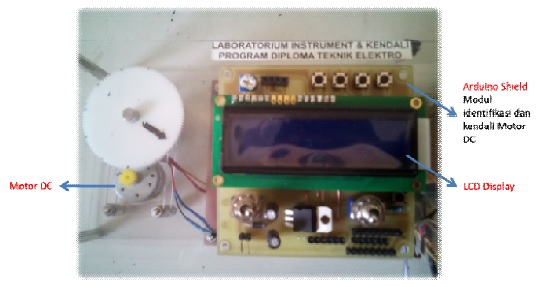Identifikasi Sistem Motor DC dan Kendali Linear Quadratic Regulator Berbasis Arduino-Simulink Matlab
Abstract
This paper describes the identification process of DC motor system with experimental technique using indetification tool in Matlab. After the DC motor model system is obtained, the optimal control technique in this case using linear quadratic regulator (LQR) is used to view the system response step. In this research, the motor modification system module with Arduino DC was developed to facilitate in terms of getting the model of DC motor by approaching first and second order models. This module is integrated between Arduino and Simulink Matlab which is used as input-output data acquisition. The result of the system identification process is a model of DC Motor with second order ARX (Auto Regressive Exogenous) modeling. Furthermore, the implementation of LQR control technique with parameter of Q element element is sought by multiplication of transpose matrix C system with matrix C of the system. While the R element matrix in tuning experimentally with value 0.000001. From the test results obtained that LQR control produces a better system response time constant when compared to PID control.
Downloads
References
[2] Wang, Jun-Sheng, and Guang-Hong Yang. "Data-Driven Output-Feedback Fault-Tolerant Compensation Control for Digital PID Control Systems With Unknown Dynamics." IEEE Transactions on Industrial Electronics 63, no. 11 (2016): 7029-7039.
[3] Viola, J., L. Angel, and J. M. Sebastian. "Design and robust performance evaluation of a fractional order PID controller applied to a Motor DC ." IEEE/CAA Journal of Automatica Sinica 4, no. 2 (2017): 304-314.
[4] Shanmugasundram, R., K. Muhammad Zakariah, and N. Yadaiah. "Implementation and performance analysis of digital controllers for brushless Motor DC drives." IEEE/ASME transactions on mechatronics 19, no. 1 (2014): 213-224.
[5] G. Ellis, Control system design guide : a practical guide. 3rd ed 2004, Amsterdam ; Boston: Elsevier Academic Press.
[6] Raka Ardana, I Wayan. Simulasi Sistem Kontroler Pid Untuk Motor Induksi Menggunakan Perangkat Lunak Matlab / Simulink. Majalah Ilmiah Teknologi Elektro, vol. 7, no. 2, May, 2013.
[7] Haron, Hartini Sharninayati. "Linear quadratic regulator (LQR) controller design for DC servo motor." PhD diss., Universiti Tun Hussein Onn Malaysia, 2013.
[8] Srivastava, Saurabh, and V. S. Pandit. "A scheme to control the speed of a Motor DC with time delay using LQR-PID controller." In Industrial Instrumentation and Control (ICIC), 2015 International Conference on, pp. 294-299. IEEE, 2015.
[9] L. Ljung, System Identification Theory for the User, 2nd ed., Prentice Hall, CA: Linkoping University Sweden, 1999.
[10] L. A. Zadeh, “On the Identification Problem,” IEEE Transactions On Circuit Theory, vol. 3, no 4, pp.277-281.1956.
[11] Yu, Gwo-Ruey, and Rey-Chue Hwang. "Optimal PID speed control of brush less Motor DC s using LQR approach." Systems, Man and Cybernetics, 2004 IEEE International Conference on. Vol. 1. IEEE, 2004.
[12] Peng, Jinzhu, and Rickey Dubay. "Identification and adaptive neural network control of a Motor DC system with dead-zone characteristics." ISA transactions 50.4 (2011): 588-598.
[13] Ogata, Katsuhiko. Modern Control Engineering Third Edition. New Jersey, Prentice Hall, Upper Saddle River. 1997.
[14] Wang X, Yin T, Chen J, et al. Rapid design of Motor DC speed control system based on Matlab[J]. Applied
Mechanics & Materials, 2015, 743:168-171.
[15] L. Ljung, “Prediction error estimation methods”, Circ. Syst. Signal Process. 21 (2002) 11–21.
[16] G. H. Shakouri and H. R. Radmanesh, “Identification of a continuous time nonlinear state space model for the extenal power system dynamic equivalent by neural network,” Electrical Power and Energy Systems, vol. 31, pp. 334-344, 2009.
[17] Tang, Wei-Jie, Zhen-Tao Liu, and Qian Wang. "Motor DC speed control based on system identification and PID auto tuning." Control Conference (CCC), 2017 36th Chinese. IEEE, 2017.
[18] Ismeal, Godem A., Karol Kyslan, and Viliam Fedák. "Motor DC identification based on Recurrent Neural Networks." Mechatronics-Mechatronika (ME), 2014 16th International Conference on. IEEE, 2014.
[19] Kamdar, Sauyma, Harsidh Brahmbhatt, Tigmanshu Patel, and Manish Thakker.


This work is licensed under a Creative Commons Attribution-NonCommercial-NoDerivatives 4.0 International License.

This work is licensed under a Creative Commons Attribution 4.0 International License




